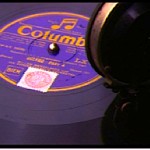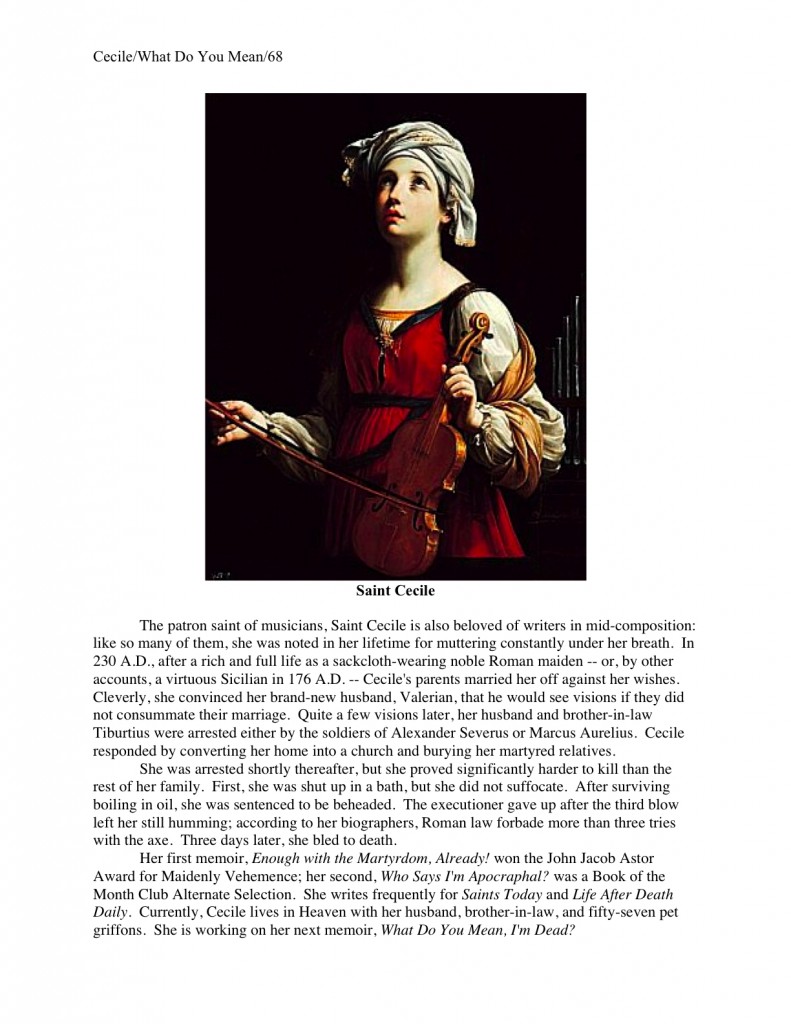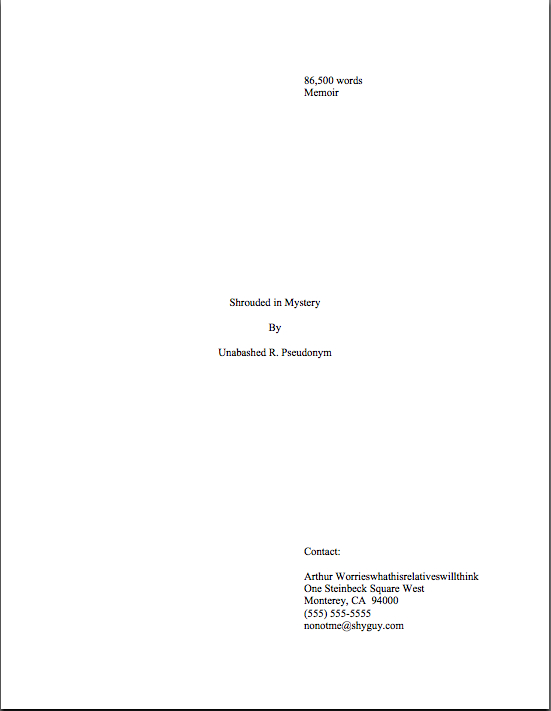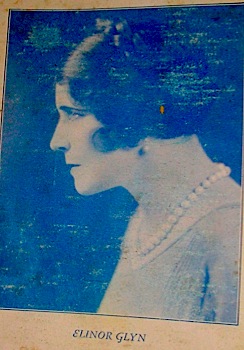
I’m smiling myself this morning, campers, although not quite as widely as Jack. Congratulate me, for I am officially the Nicest Lady in the Neighborhood, a title I hope to hold until next Halloween rolls around. How did I score this enviable title? Well, I am usually in the running: ours is the only house within a multi-block radius that gives out full-size candy bars. (You should see the look on the little ones’ faces when they first clap eyes on our candy tray.)
This year, however, we also had the dubious distinction of being one of the only houses in the neighborhood giving out candy at all. Blame the economy, not the neighbors, I say, but naturally, it was hard for the kids to understand. So I told them that if they went away for half an hour and came up with a story about the characters they were impersonating for the night, they could each have another three candy bars. One especially creative ninja reappeared three times, each with a different tale to tell.
I heard some great stories. Score one for the future writers of America, and a big loss for dental hygiene.
Back to business. I’m going to be wrapping up author bios and photos today, tying up a few loose ends and answering a few perennial first-time autobiographers’ lingering questions. Since this is my last Authorbiopalooza post — presuming that no one posts a magnificently insightful follow-up question as a comment over the next few days, hint, hint — I’m going to seize the opportunity to say something vital just one more time, for the benefit of all you procrastinators out there.
 Please, I implore you, do not put off writing at least a viable first draft of your bio until the day after an agent or editor has actually asked you to provide one. Set aside some time to do it soon.
Please, I implore you, do not put off writing at least a viable first draft of your bio until the day after an agent or editor has actually asked you to provide one. Set aside some time to do it soon.
Why? Because unless an agency’s submission guidelines ask for a bio up front, chances are, the request to provide one is going to come swooping down at you out of a pellucidly blue sky. Tossed out as an afterthought just after you’ve given the best pitch in the history of Western civilization, for instance, or when the agent who fell in love with your first 50 pages asks to see the rest of the book. It will seem like good news — until you realize that you need to come up with a bio within the next forty-eight hours.
On that happy day, you will be a much, much happier human being in every way if you already have at least the beginnings of a great bio sitting on your hard drive. Trust me on this one.
To that end, may I suggest that those of you involved in writers’ groups — critique-based or support; in either case, good for you — devote part of a meeting to brainstorming about and giving feedback on one another’s bios? Or query letters, for that matter? And what about synopses?
Don’t look at me so blankly. Why wouldn’t a success-oriented group of writers want to invest time in mutual critique of marketing materials? Long-time readers, chant it with me now: every single sentence on every single page in a query or submission packet is a writing sample. It all needs to be polished.
It also, at the risk of starting up that broken record player, all needs to be interesting — and that’s where a little outside perspective can be very helpful. Yet even very market-focused critique groups seldom set aside time for mutual bio critique. A trifle mystifying to me, as a session devoted to it can be a whole lot of fun, as well as very useful indeed.
Besides, how much do you really know about that sharp-eyed person who keeps barking at you to show, not tell?
Speaking of great questions (yes, I know; I was speaking of it several paragraphs ago, but humor me here), let’s get right to the promised answers to past reader questions on bio-related points. Yes, shorter versions of these answers are already available elsewhere on this site, but since the comments are not searchable from your side of the site and not everyone reads the comment strings — especially, I notice, whilst perusing the archives — I wanted to have all of this information gathered in one place, all ready to pop up in a site search using that nifty search engine located in the upper right-hand corner of this page.
I love readers’ questions, because, frankly, you clever souls often come up with angles it would not otherwise have occurred to me to pursue. Those of us who have been staring at bios, queries, synopses, and professionally-formatted manuscripts for years may be able to tell in an instant how the page in front of us is not right, but since we have such a strong mental image of what the right format, for instance, is, we seldom invest time in considering how someone who had never seen a successful author bio formatted for submission, for example, might picture it.
That’s why, in case anybody had been wondering, I so often encourage my readers to ask challenging questions of agents and editors at conferences: the question that’s been bugging you for months might not be one a speaker would know to include in her talk. So for heaven’s sake, ask; it’s good for everybody concerned.
To illustrate, here is a question from intrepid reader Doug about how a writer using a pen name might approach the bio. Specifically,
Is the author’s name one’s pseudonym (when applicable)? Both in the heading and in the text?
This is a great question, Doug, one that I’m positive perplexes many a pseudonymous writer. To make sure that we’re all on the same page, so to speak, what Doug is inquiring about is the boldfaced author name at the top of the bio, as well as how to refer to the author within the bio itself. To borrow an example from last time, so we may see how the author’s name dots the page:

In the bio, the author’s name should be the same as it is on the title page and in the slug line; it’s confusing if they’re different. So if you’ve decided to use a pseudonym under the By… part of the title page (as opposed to the contact info, which should use the name to which you’d prefer to have your royalty checks made out), be consistent throughout your query or submission packet.
You want to see that in action, don’t you? Fair enough.

If Arthur Worrieswhathisrelativeswillthink were to write an author bio — and he would definitely need to do so, even for a memoir, despite the fact that the entire manuscript could be construed as a bio — he has a choice: he can either show his real name on the bio, or he can list his pen name, Unabashed R. Pseudonym, as long as it is the name he uses (a) appears on the title page, as we’ve seen above, and (b) is the name in the slug line at the top of every manuscript page. In a first book, it’s usually more prudent to use one’s real name, so that contracts — like, say, the representation agreement Arthur wants the agent of his dreams to offer him — are made out properly.
One’s agent does, after all, have to know one’s real identity. So unless you are an international man of mystery fleeing justice (which would look terrific in a bio), it doesn’t really make sense to use a pseudonym at all at the querying or submission stage.
Think about it: a writer using a pen name doesn’t actually have to commit to it until after a publisher has already acquired the book. Both the representation contract and the publication contract are under the author’s legal name (although the publication contract may well stipulate the use of a pseudonym), so unless you feel that
(a) using your real name might somehow harm the book’s chances with the agent of your dreams (Begrunga Nevercleansherkitchen would be a lousy name for a cookbook writer, for instance),
(b) you already have something published in a different book category under your real name and want to avoid confusion, or
(c) you don’t want to tip Interpol off to your whereabouts,
you don’t really need to stress about the pseudonym issues until later on. Give your pretty little head a rest; you wouldn’t want your eyes to look tired in your author photo.
Everybody clear on that? Excellent. Here’s a thought-provoking question from long-time reader Gordon:
I’m not sure how to word this, but I’ll try – should an author bio written by an unpublished (in any media) writer include what you call ‘promotional parts’? Meaning life connections with the novel’s subject matter. As a youngster in his seventies there have been many twists and turns in my life. Should one’s bio chronologically hit the high points or mainly focus on the ones pertinent to the novel being submitted?
You did fine on the self-expression front, Gordon. The short answer is yes, on both counts.
Well, glad to have cleared THAT up. Moving along…
I didn’t really fool you there, did I? Especially since those of you who have been following Authorbiopalooza closely undoubtedly immediately cried, “Wait, Anne dealt with this in an earlier post. Perhaps she is trying, albeit clumsily, to drive home the point that good questions from readers help to expand the range of her posts.”
Well, I like to think so; I am, after all, the Nicest Lady in the Neighborhood, and this is an extremely common writerly conundrum. Let’s tackle it directly.
The direct answer: it depends.
To be specific, which way one should fall on the choice between devoting one’s bio to a chronological account of the highlights of one’s life as, say, an obituary might tell it (sorry, but it’s the obvious analogy) vs. creating the impression that every significant event in one’s life was leading inevitably to the writing of this book and no other depends largely upon several factors, including:
a) whether there are events in one’s life that are legitimately related to the subject matter of the book in question — and if they are easy for the reader to follow without too many logical leaps.
If mentioning a particular life experience would tend to make you a more credible source, it’s usually to your advantage to include it in your bio, to differentiate yourself from any other yahoo who might just have been guessing what that particular experience was like. Expressive Q. Author visited the Statue of Liberty once, when Expressive’s protagonist passes through Ellis Island briefly in Chapter Two, is a stretch; Expressive Q. Author spent twenty years as a merchant marine, when his entire plotline takes place on a pirate ship, is not.
b) whether one has genuinely lead a life that would produce a couple of entertaining paragraphs, regardless of connection to the book.
It never hurts to sound darned interesting in your bio. However — and in practice, this is a BIG however — writers of purely chronological bios often…how shall I put this delicately…overestimate the detail in which a rushed industry type might want to hear the life story of someone she has never met.
Remember, Millicent the agency screener reads a lot of bios; keep yours snappy.
If you’re in doubt whether yours is leaning toward overkill, hand your bio to someone who doesn’t know you particularly well (having asked politely for his assistance first, of course; don’t just accost a stranger) and have him read it through twice. Buy the cooperative soul a cup of coffee, and around the time that your cup begins to seem light in your hand, ask your guinea pig to tell your life story back to you uninterrupted.
The points that he can’t reproduce without prompting are probably inherently less memorable than the ones he can recount in glowing detail. Ask yourself about the ones left out or garbled: they honestly helping you look interesting and/or credible?
c) in the lucky instance where both (a) and (b) are genuinely true, whether the wealth of interesting biographical detail threatens to render the connections to the book less memorable.
When in doubt, lean toward the directly applicable; it’s more important information for the marketing department.
Remember, the point of an author bio is not to tell your life story — that’s what post-publication interviews and memoirs are for, right? — nor to include all of the things that you would like total strangers who pick up volumes in a future bookstore to know about you. The goal in a query or submission bio is to make the case that you are an interesting person well qualified to have written the book in question. Or, in the case of nonfiction, to write the book being proposed.
Everyone clear on the relevant distinctions? Good. Let’s move on to another question. Another long-term reader, Cerredwyn, wrote in to ask,
Does an author photo need to be a head shot?
No, it doesn’t — as long as you are identifiable (“That’s she, officer. That’s the author of the book!“) and the background isn’t too busy, you can certainly use a broader shot.
In fact, as Elinor Glyn’s author photo for IT clearly demonstrates, a head-and-torso shot is perfectly acceptable, and actually a bit more common on jacket flaps than the pure headshot.
However, 1/2, 3/4, and even full standing shots are not unheard-of. John Irving’s early works tended to have particularly hunky-looking shots from the waist up, for instance.
Not that I noticed as a teenager or anything. I was reading his books for the writing and the stories, I tell you.
If you’re having trouble deciding between different ranges of shot, spend some time in a well-stocked bookstore, taking a gander at the author photos published in books in your chosen book category within the last few years. Not in every new release, mind you, but in books like yours. If you notice an overall trend in styles, you’re not going to offend anyone by submitting something similar.
Oh, and speaking of styles, unless you have written something ultra-hip or happen to be a magazine writer (whose material by definition changes constantly), it’s usually not a great idea to dress in the latest fashion for your author photo — and it’s DEFINITELY not the time to sport a hairstyle that’s not likely to be around a decade hence.
Don’t believe me? Ask any 80s author who embraced a mohawk. Or Elinor Glyn, a decade after the photo above was taken.
Remember, if your book is successful, it will be gracing shelves in private homes, libraries, and book exchanges for even longer than it will be hanging out in Barnes & Noble. A too-trendy style will date the photo. So as a general rule, adorning yourself for your photo with the expectation that the resulting photo will dog you for the rest of your natural life is a good plan.
You also might want to give some thought to how certain colors and patterns photograph — and how a checkered jacket that works beautifully in an 8 x 10 glossy might just look dusty in a 3 x 5 or 2 x 3 (both fairly common sizes for jacket photos). Generally speaking, solids work better than prints, and strong, dark colors on the body are distract less from the face. Bear in mind, too, that black, white, and red sometimes look quite different in print than in real life, and that the eye tends to zoom in on the red and the shiny.
If that’s your lip gloss, great; if it’s your belt, less great. Unless you are trying to find an agent or publisher for a book about belts, that is.
The answer to the next reader question, posed by Jaepu, could be extrapolated from the last paragraph but one, I notice, but that doesn’t mean it isn’t a trenchant question. Let’s revisit it, just in case anyone out there was wondering:
Must the author photo be in color?
No, it may be in black and white — in fact, until fairly recently, that was the norm. However, with the rise of digital photography, color author photos have become more common. Do be aware, though, that a black-and-white photo won’t tell an agent whether you might look good in a television interview as well as a color picture would.
The more important issue is photo clarity. You’d be surprised at how many author photos are actually out of focus, presumably because the writer prefers the blurry shot to other, clearer ones. (Either that, or he moves around too quickly to be caught easily on film.)
Nor is this a time to make a funny face, even if you write humor; this is, after all, a photo intended to present you as a professional to be taken seriously. Let’s face it, even if a less-sharp image is genuinely cool, this image of trick-or-treating expert Jack O. Lantern

is simply not as effective a marketing tool as this comparatively mundane smile.

My apologies to those with low self-esteem, but the author bio photo actually does have to look like you. Not some idealized, air-brushed ideal version of what someone who spends hours on end frantically tapping her thoughts on a keyboard, but you.
Pop quiz: what is good about both of these photos of Jack? (Hint: it has to do with his area of expertise.)
If you immediately cried, “By jingo, he’s depicted in a context that is relevant to the subject matter of his book!” take a candy bar out of the jar. Since Jack is writing about trick-or-treating, what would be a more natural background than his Halloween locale?
In fact, he could even take it a step farther, sacrificing a bit of facial close-up range for a photo that unquestionably establishes him as someone who knows his Halloween doorsteps. As long as his face is clearly visible, a slightly farther-away shot is fine.

Speaking of low self-esteem, a reader apparently too shy to be comfortable with self-identification asked:
I’m all excited about my next book, but I’m marketing my first. Would it be completely tacky to mention what I’m working on now in my bio? What if the books are in different genres?
It’s far from being tacky, Anonymous One; in fact, it’s downright common for a bio to end with a mention of the author’s next writing project. Try to keep it to a single sentence, however, so it does not overpower the rest of the bio.
Lincoln lives in Springfield, Illinois with his wife, eight sons, and golden retriever, Manifest Destiny. He is currently working on his second book, Hey! Where Are You Taking Half of My Country?, a comic memoir covering the Civil War years.
“Yeah, right, Anne,” I hear some of you scoff. “Stop pulling our collective legs. I’ve never seen an author bio on a book jacket that covers future work, or even unpublished work. Bios, like tombstone epitaphs, are always backward-looking, aren’t they?”
Actually, jacket bios that mentioned future projects used to be fairly standard; in the mid-70s, the last line of most dust jacket bios was some flavor of Smith lives in Connecticut, where he is working on his next novel. Gradually, this has been falling out of fashion, perhaps because it implies some faith on the publisher’s part that Smith’s current release will sell well enough that they will WANT him to bring out another. (It’s probably not entirely a coincidence that this particular last sentence fell out of fashion at approximately the same time as multi-book contracts for first-time novelists.)
However, the author bio that an aspiring writer tucks into a query or submission packet and the one that ends up on a dust jacket are not the same thing — as we discussed earlier in Authorbiopalooza, they are intended for the eyes of two different audiences, to create two different impressions. The dust jacket bio is promotional copy aimed at the reader, designed to pique interest and answer basic questions like why should I believe this guy’s NF account of life on the moon? The query or submission bio, by contrast, is designed to impress agents, editors, and their respective Millicents with the author’s claim to be an interesting person well qualified to have written the book in question.
Is there an echo in here? I could have sworn that I’ve heard that last bit somewhere before.
Because the submission bio is geared for industry-savvy eyes, mentioning completed book projects in categories other than the one to which the currently-submitted manuscript belongs (try saying THAT three times fast), as the Anonymous Questioner suggested, is a perfectly legitimate use of page space. No need to hawk the other projects; simply mention the book category within the course of a single-sentence description that describes the project as still in progress. As in:
Now nicely recovered from his contretemps with an assassin, Garfield lives in retirement, working on his next book projects, a YA baseball romance and a historical retrospective of his own brief presidency.
Why would Pres. Garfield speak of his completed YA book as a work-in-progress? Strategy, my dears, strategy: it neatly sidesteps the question why isn’t it published? Clever, eh?
Finally, reader Rose inquired:
I’m at a whole single-spaced page, no photo. I have a pro photo, recently taken, that looks great. Would it be better to reduce the bio and add the photo?
I’m querying for a novel, btw — and I’d been under the impression that you shouldn’t submit an author photo when trying to pitch one.
Contrary to the impression Rose has, by her own admission, picked up she knows not where, there is no hard-and-fast rule about whether a fiction writer’s submission bio should to include a photo. No Millicent who has found a submission engaging enough to read all the way to the last page, where the author bio lurks, is going to cast her latte aside in a petulant fit at the sight of a photo, screaming, “Oh, darn — now I have to reject it. I liked that manuscript, too.”
The reason photos are often not included in novelists’ bios is not because they’re unwelcome, but because the burden for gathering marketing materials prior to selling a novel has historically been significantly lower than for a nonfiction book. (If any of you novelists doubt this, take a gander at a book proposal sometime; its many, many pages of marketing material will make you feel much, much better about having to write only a query letter and a synopsis.)
If your photo is pretty ravishing, Rose, I say go ahead and include it. A nice photo does make the bio look a touch more professional, after all, and it’s never a bad thing for an agent or editor to think, “Hey, this author is photogenic!”
Even without the picture, though, it sounds as though Rose’s bio is a bit long for professional purposes: the norm is one DOUBLE-spaced page, or 1/2 – 2/3 page single-spaced under a photo. Yes, one does occasionally hear agents mentioning that they’ve been seeing more single-spaced full-page bios lately — but as I’ve virtually always heard this pronounced with a gnashing of teeth, I’m inclined to regard such statements as complaints, not cries of rapture.
Call me zany, but I tend to interpret moaning as an indication that the moaned-about activity is unwelcome. I’d stick to a more standard length. As with a query letter, when in doubt, err on the side of brevity. Believe me, if your bio is too short, the agent of your dreams will be only to happy to tell you so –after she signs you.
(Don’t cringe: she’s going to want you to change a lot of things after she signs you, no matter how much she initially loved your book or book proposal. Don’t say I didn’t warn you.)
One last thought on the subject before I sign off for the day: stick to a single page, unless you are specifically asked for something much longer or shorter. (Requests for 1- or 2-paragraph bios aren’t that uncommon.) Beyond that, try not to obsess too much about length. Concentrate instead on sounding fascinating.
Seriously, if, over the years I’ve been a book doctor and particularly over the 5+ years I’ve been answering questions online, someone had given me a nickel for every time an aspiring writer asked me whether the spacing or length of the bio — or query, or synopsis — REALLY mattered, I would have been able to build my own publishing house.
I don’t mean that I would have been able to buy one; I mean that I would have been able to construct the necessary buildings and offices entirely out of coins.
Would it surprise you to hear, then, that even after that many repetitions of the same question, my answer has never changed, no matter how much aspiring writers might have wished it to do so? Or that if I could wave my magic wand and remove all formatting requirements, I probably wouldn’t do it?
Why, I hear you gasp? Because when an author bio — or query letter, or synopsis, or manuscript — is properly formatted, the only bases for judging it have to do with the quality of the writing, the premise’s marketability, whether the professional reader likes it, and so forth.
You know, the bases upon which aspiring writers WANT to be judged.
So yes, agents really tend to hold aspiring writers to the standards of the industry, just as they hold their clients to them. (See earlier comment about one’s dream agent making demands upon one.) They don’t do this to be mean; it’s just that when someone — like, say, Millicent — spends hour after hour, day after day, month after month staring at manuscripts, she’s unlikely not to notice if one is formatted differently than the norm.
As in, for instance, an author bio that doesn’t look like the ones I showed you last time. Even if a single-spaced bio sans photograph does indeed fit onto the requisite single page, thus meeting the bare minimum standard for professionalism, it’s not going to resemble the bios Millicent’s boss is sending out with her clients’ submissions.
Or at least, it probably will not. Naturally, as with any group of human beings, some agents have individual preferences that deviate from the industry standard — the source, I suspect, of Rose’s impression of unspecified origin — and if you can find out what these quirky desires are, you should definitely adhere to them in your submissions to that particular agent. It seldom pays, however, to assume that any one such preference is universal to the industry.
My point is, as annoying as it may be to bring your bios — and queries, synopses, and manuscripts — into line with the most common professional standards is so that Millicent may ignore the formatting and concentrate on what you are SAYING. Because, after all, your aim in your submission bio is not to cram as many facts as you can onto a single page, but to make the case that you are an interesting person well qualified to have written the book in question.
Yes, you have heard that somewhere before. See, I don’t recommend sticking to the general standards just to be mean, either.
Congratulations, campers: I don’t know whether you have noticed it, but since Labor Day, you have completed a crash course in all of the standard elements of the query and submission packet. Which, in case you are the kind who likes to track such things, makes you more knowledgeable about how to market your writing to agents than roughly 97% of the aspiring writer population.
You should be very, very proud of yourself for taking the time — let’s face it, many of these posts have been hefty — to learn how to present yourself professionally. Keep up the good work!
